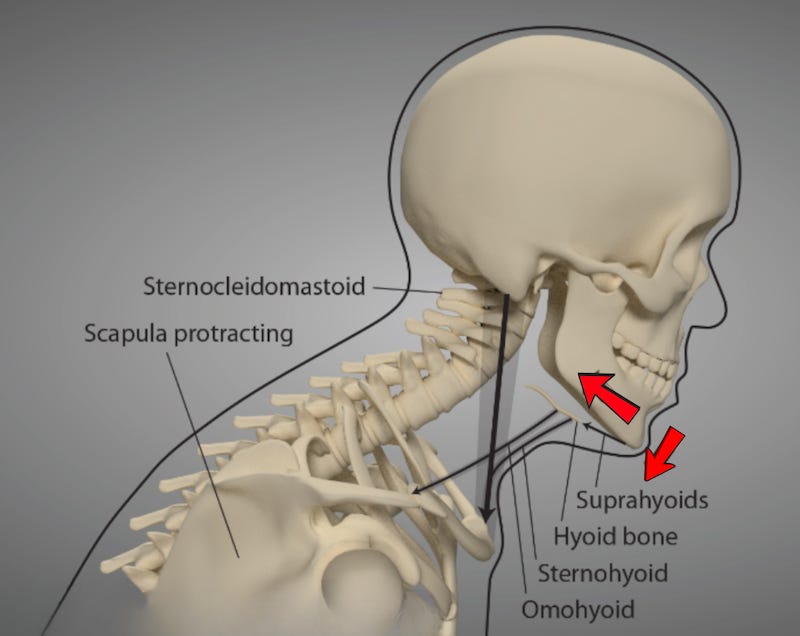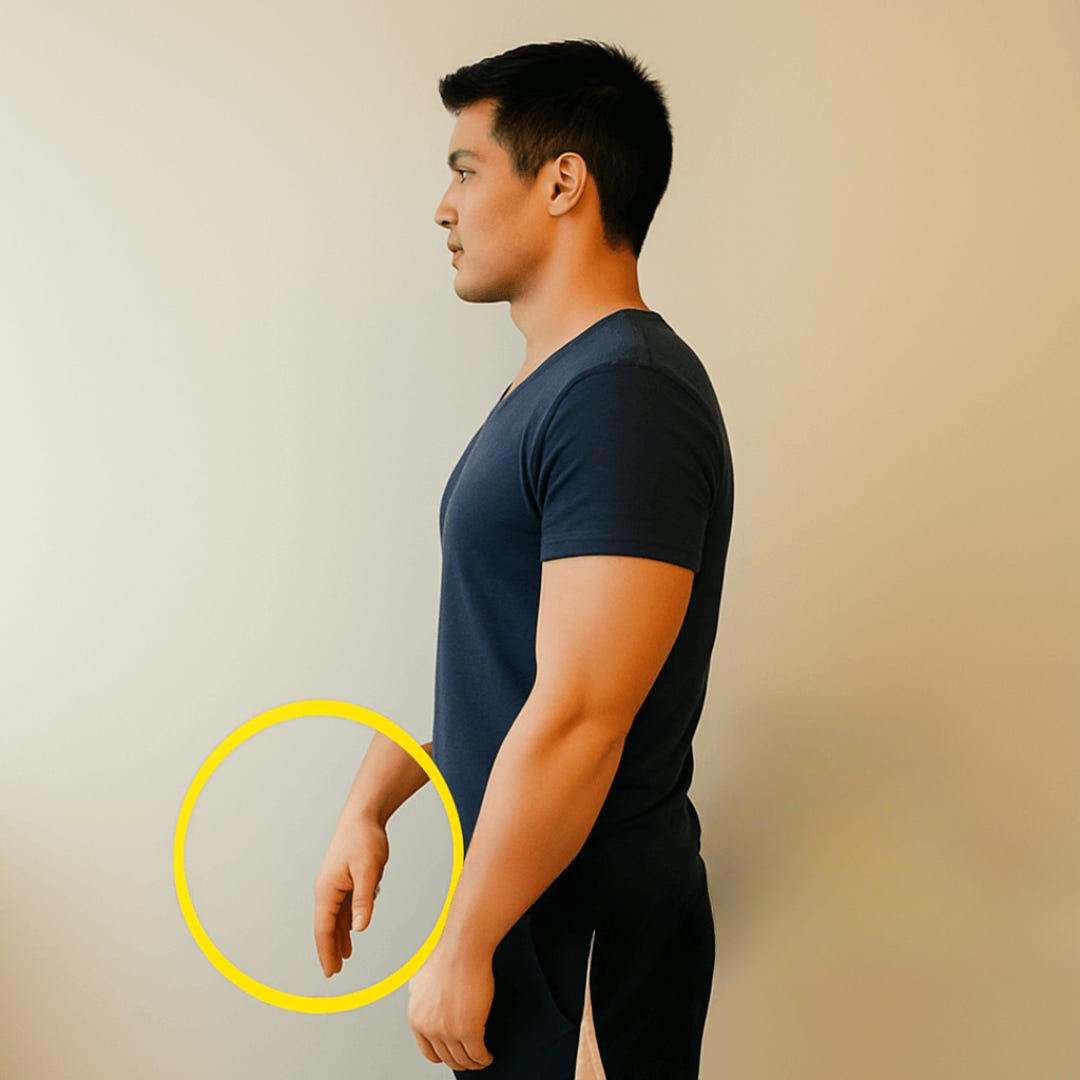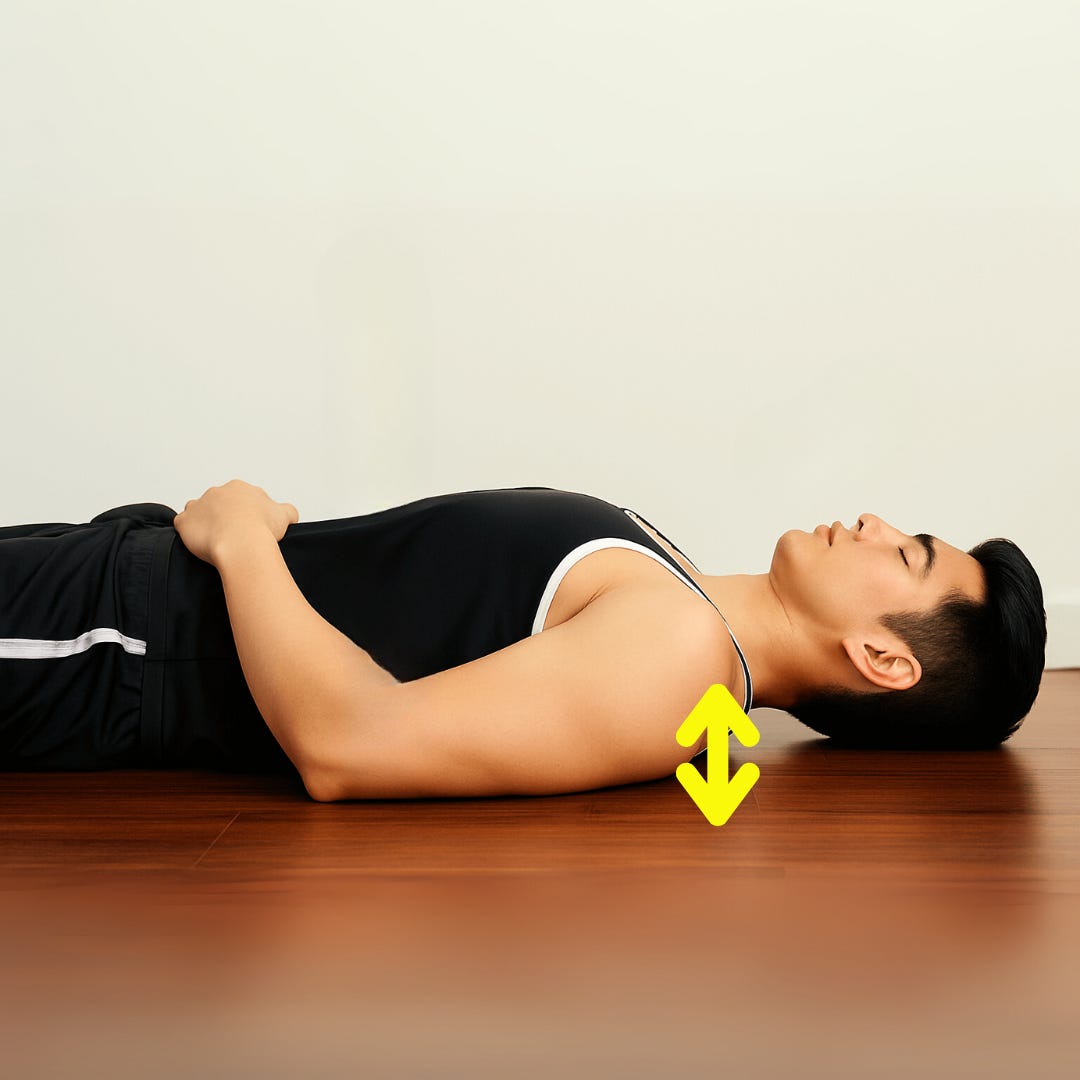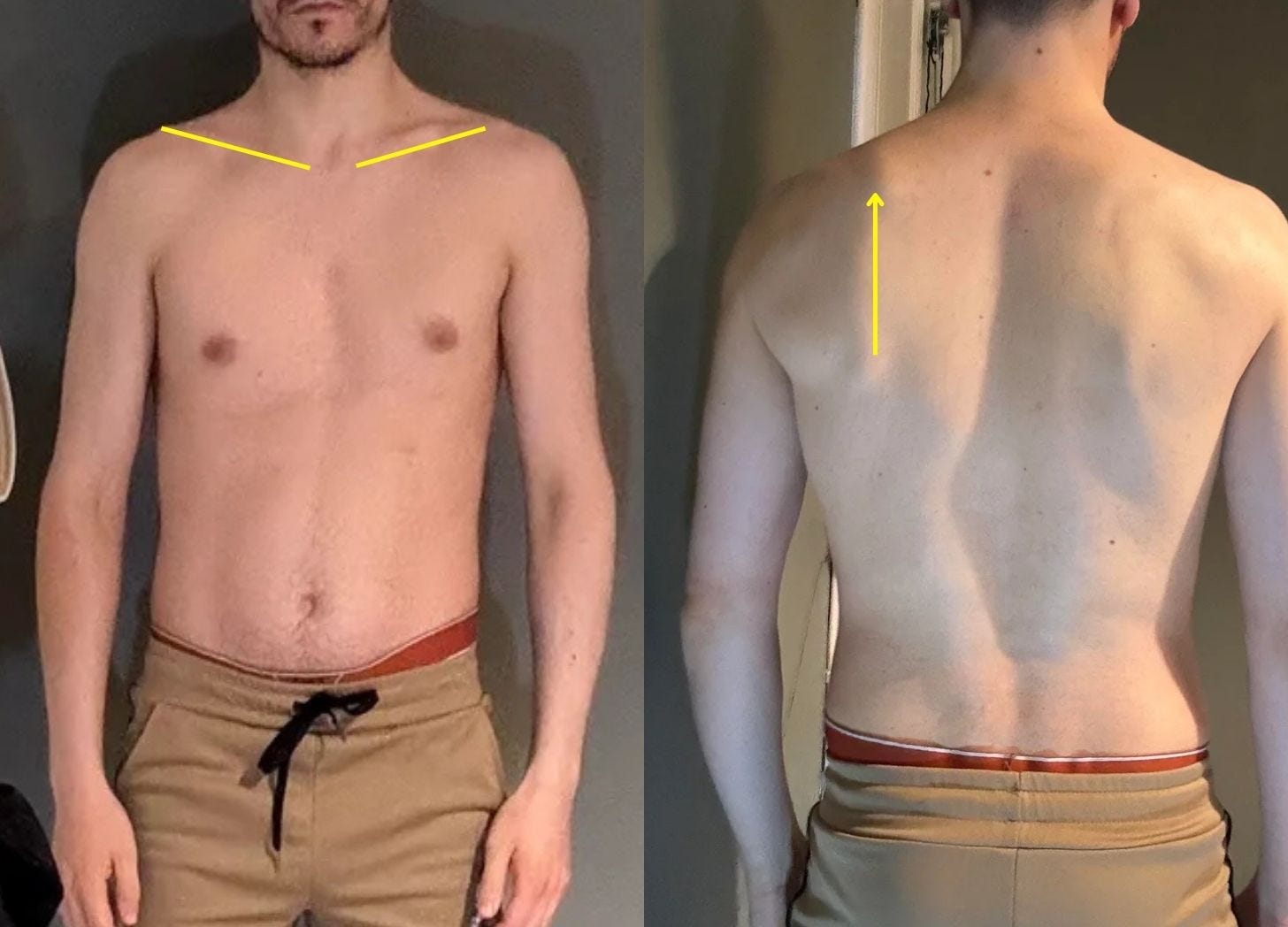How to Fix Rounded Shoulders
This blog gives you the most effective exercises and proven strategies to correct rounded shoulders at the root.
Rounded shoulders pull the shoulder blades forward and tilt the upper ribs inward. This causes the upper back to hunch and the head to jut forward.
As the head shifts, the cervical spine loses its natural curve, placing excess stress on the vertebrae and discs.
The neck muscles then tighten to support this misaligned position, compressing the cervical joints, reducing mobility, and increasing the risk of nerve impingement, chronic tension, and pain at the base of the skull.
If you feel tension in your neck, pain behind your shoulders, or stiffness when lifting your arms overhead, your brain may be locked into a faulty postural loop.
By the end of this post, you’ll see why your shoulders keep collapsing forward no matter how much you stretch or strengthen. You’ll learn the exact reset that targets the hidden sensory systems controlling shoulder and spine alignment. It’s not about pulling your shoulders back. It’s about fixing the inputs that keep pushing them forward.
Let’s break down the real cause of Rounded Shoulders and show you how to correct it from the source.
What Are Rounded Shoulders?
From a body mechanics perspective, rounded shoulders happen when your shoulders roll forward and your upper back begins to hunch. Instead of your shoulder blades resting flat on your back like they should, they tip forward and spread apart. This pulls your arms inward, collapses your chest, and shifts your head out in front of your body.
The muscles in the front of your shoulders and chest become tight and overactive. The muscles in your upper back and spine that are supposed to hold you upright become weak or shut down. Your neck loses its natural curve. The joints in your cervical spine get compressed. And your body slowly adapts to this position as “normal,” even though it’s anything but.
The Real Cause
The real cause goes deeper than just your posture. One of the most overlooked drivers of rounded shoulders is your jaw. Specifically, how your jaw sits in your skull. When the jaw is positioned too far back, it changes the entire shape of your head and neck alignment. People with this type of bite often have a recessed lower jaw and chin, which means the jaw sits further back than it should.
When that happens, the head has to shift forward to compensate. This is your body’s way of keeping your airway open and your eyes level. The forward shift of the head then creates tension down the neck and across the shoulders. Over time, this pulls your shoulders into a rounded position.
Rounded Shoulders may be associated with issues such as:
Chronic neck tension or stiffness
Pain at the base of the skull
Compression of cervical vertebrae and discs
Trapezius tightness or upper trap trigger points
Mid-back stiffness or pain
Rounded shoulders and winged scapula
Decreased shoulder mobility and impingement
Jaw tension or temporomandibular joint (TMJ) pain
Headaches (often starting at the base of the skull)
Numbness or tingling down the arms (from nerve compression)
Loss of natural cervical curve (cervical kyphosis)
A 2016 study published in the Journal of Physical Therapy Science investigated the effects of forward head posture (FHP) on forced vital capacity (FVC) and respiratory muscle activity.
The study found that individuals with FHP had significantly lower FVC and forced expiratory volume in 1 second (FEV1) compared to those with normal posture.
Additionally, the study revealed that accessory respiratory muscle activity, particularly in the sternocleidomastoid (SCM) and pectoralis major, was reduced in the FHP group. These findings suggest that FHP can negatively impact respiratory function, potentially due to muscle weakness or imbalances.
4 Quick Ways to Test If This Is You
These take less than a minute:
1. Side Photo
Snap a photo of yourself from the side. Do your shoulders sit ahead of your midline?
→ That’s a sign of a forward shift in your upper body.
2.Palm Position Test
Stand naturally. Do your palms face your thighs or turn inward?
→ Inward = internal rotation and protraction.
3.Lying Shoulder Contact
Lie flat on your back. Do your shoulders touch the floor?
→ If not, they’re likely pulled forward off the ribcage.
4.One Shoulder Forward?
Face a mirror. Is one shoulder more forward than the other?
→ That’s often a rotational pattern driven by visual or jaw asymmetry.
The 5-Minute Reset to Fix Rounded Shoulders
Step one is to reset the tongue posture using a Functional Activator. This helps bring the jaw forward and into better alignment, which takes pressure off the neck and helps the shoulders naturally open up. Step two is to address the feet using Therapeutic Insoles. If your head has been shifting forward for years, your feet have adapted to that imbalance. Correcting foot input restores proper alignment from the ground up and helps your body find a more stable, upright posture.
We reset posture from the brain down. No excessive stretching. Just smart inputs.
If your shoulders always feel tight no matter how much you stretch, the
5-Minute Posture Fix gives you the exact reset to release that constant
tension from the source. It’s not about forcing your body into position.
It’s about finally giving it the input it’s been missing.Chest Release
Lie on your stomach with your chest facing the floor.
Position a massage ball under your chest, just beside the sternum—not directly on it.
Let your body sink into the ball with as much pressure as feels tolerable.
Slowly roll your chest in small circles to explore tight areas.
Shift the ball side to side or up and down to cover the full chest region.
Continue this for about 2 minutes, focusing on steady breathing as you release tension.
Upper Trap Wall Release
Stand facing the corner of a wall.
Gently bend forward at the hips.
Position a massage ball between your upper trapezius (the area between your neck and shoulder) and the wall.
Lean your body into the ball to apply pressure.
Roll slowly to explore tight or tender spots along the upper trapezius.
Shift the ball slightly to target different areas within the region.
Maintain steady breathing and continue for 2 minutes per side.
b) Side
Target muscles:
Latissimus Dorsi
Serratus Anterior
Instructions:
Lie down on your side.
Place a foam roller underneath the Serratus Anterior/Latissimus Dorsi muscle.
Apply an appropriate amount of your body weight on top of the foam roller.
Roll your body over the foam roller.
Make sure to cover the entire muscle.
Continue for 2 minutes on each side.
Subscapularis
Sit comfortably on a chair and let one arm rest fully on your lap.
Allow the entire arm to go limp so the surrounding muscles can release.
With the opposite hand, use your fingertips to gently press into the front edge of your shoulder blade—reaching into the armpit area.
Search for areas that feel dense, sore, or tender.
Apply slow, consistent pressure to those tight spots.
Continue for about 30 seconds while keeping your breathing calm and steady.
Latissimus Dorsi
Stand in a doorway and grip the doorframe with one hand.
Allow your upper arm to support your body's weight as you let your torso hang loosely.
With your legs positioned as demonstrated, focus on curving your midsection as much as you can.
Let your body weight deepen the stretch.
Target a gentle stretch along the side of your torso.
Hold the position for 30 seconds.
Switch sides and repeat.
Internal Rotation Overpressure
(Muscles targeted: Infraspinatus, Teres Minor)
Position the back of your wrist against the side of your hip.
Use a strap (or your opposite hand) to gently draw your elbow inward toward your body.
Focus on feeling a stretch in the rear of your shoulder.
Complete 30 repetitions.
Conclusion
To address rounded shoulders, follow these steps:
Fix your. posture first. Stretching and strengthening won’t hold if your brain is still running on the same distorted map.
Release and stretch the tight muscles pulling your shoulders forward.
Activate and strengthen the weakened muscles that help align your shoulders correctly.
Practice controlling your shoulder blades, focusing on posterior tilt and retraction.
Fix the input. Rewire the system. That’s how you create lasting change.
What to do next:
💡 If you’re ready to go deeper, our full Course Pack which includes the Brain Coach Performance Certification. This program give you the tools to understand and fix posture long term by addressing the body as a whole. Everything starts with the brain, and these courses show you exactly how to support it, step by step.
















I preach this all the time in my training. Especially when I’m dealing with people with head and neck, cancer or breast cancer due to the surgery and or radiation along with the scar tissue and possibly adhesions. I tell people that if they’re doing the wrong exercise exercises it’s simply going to exacerbate it. For example, doing chest presses or push-ups when in this position, even doing crunches, can make it all worse. I try and get people back to baseline before adding those exercise exercises back in. What are your thoughts on that?
Do you have a youtube video about this with exercises demonstrations? Thank you!